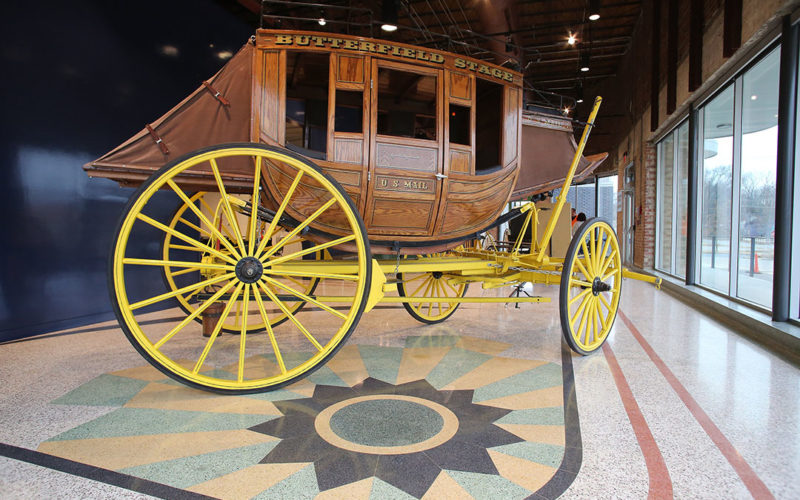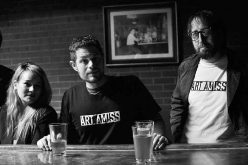Rogers Historical Museum ready for its closeup
BECCA MARTIN-BROWN
bmartin@nwadg.com
It takes a village to collect, preserve and present the history of a village — especially one that boasts the long, varied and and ever-changing dynamics of the city of Rogers. In the last year, citizens of that village — paid and unpaid, corporate and private, artisans, historians, architects, builders, forklift drivers and more — have worked to renovate a 1947 building; move, redesign, revamp and repurpose exhibits; and create a new Rogers Historical Museum that is accessible in every sense of the word.

The Free Weekly/DAVID GOTTSCHALK
Robert Rousey (left), curator of education, and John Burroughs, director of the Rogers Historical Museum, talk about the child-sized kitchen built for the museum by Bob Rich of Rogers. Although it looks like it’s metal, it’s actually constructed of wood.
All of that work comes to fruition on Dec. 13, when the museum reopens in its new home in the Hailey Ford Building at 313 S. Second St. in Rogers.
“We couldn’t have done it without so many hands, so many different skills and talents,” says John Burroughs, the museum’s director, pausing during a walk-through to consult with Richard Calloway, curator of exhibits. Calloway is in the process of hanging images of important Rogers citizens — Erwin Funk, Betty Blake, Louise Thaden — in a storefront remembering Stroud’s Mercantile, which, when it closed in 1993, was the oldest continuously operated privately owned retail business in the state. Burroughs returns from the conversation covered in sawdust; he had to stop and drill some holes.
And that says everything about the last year for the museum’s staff: Everybody has done everything they could — and when they couldn’t, they called in experts to help. Former director Gaye Bland, for example, jumped in to do research and write exhibit cards. Sam Syzdek of Mulberry created what Burroughs calls the “best and most accurate model” of the Van Winkle Mill, which existed between 1850 and 1890 east of Rogers. Bob Rich of Rogers volunteered his time to create the front end of an almost life-sized train engine and — on the other side of the gallery — a half-sized turquoise-colored 1950s kitchen as part of the interactive children’s section. You’d swear both the refrigerator and the train were metal — until Robert Rousey, a volunteer who worked his way up to curator of education, knocks on them. They’re wood — which should be no surprise, having seen the full-size stagecoach built by Rich and currently on exhibit in the museum’s lobby.

The Free Weekly/DAVID GOTTSCHALK
A scale replica of Rogers Public High School exhibits photos and information about school days, but it also includes a slide for busy children.
But museum staff members also put all of their skills to the test. Calloway was trained as an architect, and his expertise was “invaluable,” Burroughs says, for understanding all of the codes and regulations that came into play during the renovation.
Actually, he admits, the museum did pay an exhibit designer — briefly.
“But what he created just was jarringly different from what we envisioned,” Burroughs says. “We wanted this new museum to look and feel like the Rogers Historical Museum.”
Forty years in the making
The story of the Rogers Historical Museum goes back to 1974, when councilwoman Opal Beck suggested creating a museum as the city’s Bicentennial project. A nine-member commission was formed, with Vera Key as chairwoman, and on Oct. 25, 1975, the museum opened in a rented 1905 former bank building. Just seven years later, the Harold Hawkins family donated the 1895 Hawkins House on South Second Street, and by 1985, the museum was so popular an addition was needed — and was funded, named in honor of Key and completed by Dec. 5, 1987.
Grass has never grown under the Rogers Historical Museum’s feet. But when planning for another expansion began in 2006, success didn’t come so easily. The first idea — to build a new structure — was rejected because of its price tag, Burroughs remembers. But when the Hailey Ford building became available in 2015, it offered not only plenty of space — an increase from 15,500 to more than 29,000 square feet — but a chance to renovate an historic 1947 structure.

The Free Weekly/DAVID GOTTSCHALK
A Ford 8N tractor was sold by Newt Hailey’s tractor dealership around 1951 and has now returned to the same downtown block as an exhibit in the Rogers Historical Museum.
It didn’t hurt that Burroughs is, in his own words, a little bit of a hoarder. People have offered him things over the years — a jail cell, a bunch of vintage doors, a tractor — and those serendipitous acquisitions have paid off. The jail cell, now featured in the museum’s new America’s Heartland Gallery, has been hugely popular with students, Rousey says. The old doors were recycled into reader rails — waist-high mountings for information — saving the museum some $300 per section. And the tractor? It’s one of Burroughs’ favorites in the collection. The Ford 8N, which dates to about 1951, was purchased by Rex Spivey, a farmer on the east side of Rogers, from Newt Hailey’s tractor dealership — which was located just behind Hailey’s car dealership. It was donated by Joe Spivey and returned to virtually the same place it started.
“It only belonged to one family, and it probably never went more than 20 miles outside Rogers,” Burroughs says, pointing enthusiastically to dirt in the tire treads that came from the Spivey farm, stains from the exhaust still visible and even some minor renovation undertaken by Joe Spivey. “It’s all … real.”
Real connections
That, says Burroughs, has always been the goal of the Rogers Historical Museum, both in the past and into the future. He wants to tell real stories of real people, and he wants to do it in interactive ways that capture the imagination of young and old alike.
“I challenge you to find a more interactive museum anywhere,” he says, not just in computer screens, but in train bells that ring, a simplified switchboard where kids can call around the children’s area, a slide inside a facade of Rogers Public High School and even an original concrete chair from Monte Ne, finally rescued from display outdoors at Frisco Park and moved to the museum. It weighs about 3,000 pounds, Burroughs says, so getting it into the new space wasn’t easy. It took that same collaborative spirit that everything else at the museum has — experts from Nabholz Construction, in this case, and a heavy-duty forklift.

The Free Weekly/DAVID GOTTSCHALK
Museum director John Burroughs says this exhibit, created by Sam Syzdek of Mulberry, is the “best and most accurate model” of the Van Winkle Mill, which existed between 1850 and 1890 east of Rogers.
The first thing visitors will see, however, is the original line of the Hailey Building, a 1947 Art Deco brick structure that was, according to historian James Hales, “considered the most attractive building in town.” Heavily modified in the 1980s by the owners of the Northwest Arkansas Morning News, it looked colonial until contractors started peeling off the facade — and found the original curved line of the windows and the original terrazzo floor, which Burroughs says would cost thousands of dollars to re-create today. When the Vitrolite glass tiles were revealed, that was the icing on the cake, Burroughs says. “We knew it was all here.”
Just to the left of the lobby is the Dick and Nancy Trammel Gallery, already in use as a meeting place for community groups. It seats between 100 and 120, Burroughs says, and gives the museum a space to host all kinds of small events.
But Rousey really hopes visitors will start their tour in the Natural State Gallery, just behind the Trammel Gallery. “It sets the stage for how the area’s natural resources shaped farming and business and how Rogers has reinvented itself over the years,” Burroughs says.
Next is the Road & Rail Gallery, taking visitors from covered wagons and log cabins to the founding of Rogers, World War I, the rise of the apple industry and how the automobile changed everything.
Visitors will then turn right into America’s Heartland, which looks at the early significant families of Rogers, the Great Depression, World War II and Korea and the rise of tourism in the region — which continues in the White River Gallery, looking at the creation of Beaver Lake and the fascinating rise and fall of Coin Harvey’s Monte Ne.

The Free Weekly/DAVID GOTTSCHALK
A small but mighty switchboard will allow children playing in the interactive section of the Rogers Historical Museum to call from room to room.
Finally — or first, for those with children — is the most interactive area of the museum, complete with Grandpa’s Workshop, the 1950s kitchen, the switchboard, the slide and a simplified version of a telegraph.
After college, Burroughs says, his first “big-time job” was at the St. Louis Science Center, evaluating exhibits and visitor experiences with them.
“It made a big impression on me,” he says. “I saw how things you could touch translated into involved patrons.”
__
FAQ
Rogers Historical Museum
Grand Reopening
WHEN — 10 a.m.-5 p.m. Monday through Saturday
WHERE — The restored Hailey Ford building, 313 S. Second St. in Rogers
COST — Free
INFO — 621-1154






